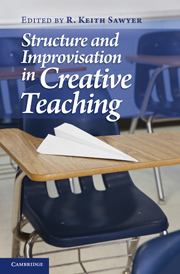Book contents
- Frontmatter
- Contents
- Table and Figures
- Notes on Contributors
- Foreword
- 1 What Makes Good Teachers Great?
- Part 1 The Teacher Paradox
- Part 2 The Learning Paradox
- Part 3 The Curriculum Paradox
- 10 How “Scripted” Materials Might Support Improvisational Teaching
- 11 Disciplined Improvisation to Extend Young Children’s Scientific Thinking
- 12 Improvisational Understanding in the Mathematics Classroom
- 13 Conclusion
- Index
- References
13 - Conclusion
Presence and the Art of Improvisational Teaching
Published online by Cambridge University Press: 05 June 2012
- Frontmatter
- Contents
- Table and Figures
- Notes on Contributors
- Foreword
- 1 What Makes Good Teachers Great?
- Part 1 The Teacher Paradox
- Part 2 The Learning Paradox
- Part 3 The Curriculum Paradox
- 10 How “Scripted” Materials Might Support Improvisational Teaching
- 11 Disciplined Improvisation to Extend Young Children’s Scientific Thinking
- 12 Improvisational Understanding in the Mathematics Classroom
- 13 Conclusion
- Index
- References
Summary
In the introductory chapter of this volume (see Chapter 1), Keith Sawyer states that the goal for this book is “to present a new theory of professional pedagogical practice” (p. 13). At the core of this new theory is the premise that “balancing structure and improvisation is the essence of the art of teaching” (p. 2). The phrase “the art of teaching” suggests that teaching – like any interactive craft that includes collaboration or live performance (e.g., “the art of conversation”) – entails two inter-related facets of expertise: mastery of a body of fundamental principles or methods governing the craft (i.e., “structure”) and mastery of skills in conducting human activity (i.e., “improvisation”). The educational scholars represented in this book share this conception of teaching; they view teaching as an improvisational activity, and they contend that “what makes good teachers great” is disciplined improvisation. Each chapter either explicitly or implicitly address the question: How can the principles of artistic improvisation in theater, music, and dance be adapted for interactive educational contexts – from student learning in public school classrooms to teacher learning at the university level? In this chapter, we discuss this body of work through the lens of two additional guiding questions:
What does this multi-layered “theory of professional pedagogical practice” look like, and how does this theory contribute to our understanding of teaching, learning, and curriculum development?
What do this theory and these applied principles mean for teacher education?
- Type
- Chapter
- Information
- Structure and Improvisation in Creative Teaching , pp. 279 - 298Publisher: Cambridge University PressPrint publication year: 2011
References
- 17
- Cited by

